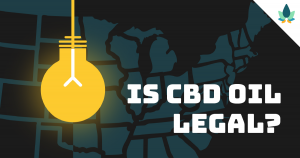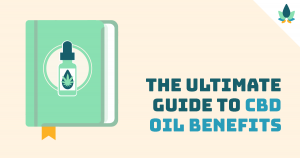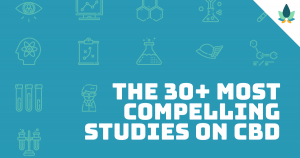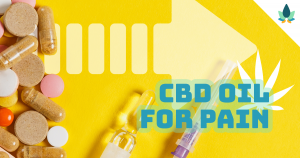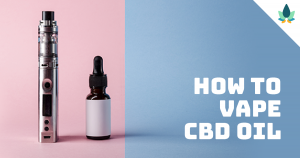Did you know that your body is designed to function better when compounds from cannabis are consumed?
Wait… What?
If you’ve heard this before and doubted it – or are wondering what exactly that means – you’ve come to the right place. It’s all made possible by the endocannabinoid system and the cannabinoids that interact with it.
So, what are cannabinoids in the first place? How and why do they help the body achieve balance? Read on to learn more.
The Endocannabinoid System: Scientific Background
The endogenous cannabinoid system is commonly called “the endocannabinoid system” or simply “the ECS.” The term “endocannabinoid” is actually an eponym arising from the Cannabis plant genus; the cannabinoids in cannabis are what led to the discovery of the endocannabinoid system.
While the endocannabinoid system and cannabinoids were relatively misunderstood up until the late 20th century, the past few decades of research have made it clear that the ECS and certain cannabinoids are essential to supporting human health and longevity. (1)
In fact, the endocannabinoid system isn’t exclusive to just higher life forms like humans (mammals); many species before us on the evolutionary tree of life have the endocannabinoid system, even 500 million-year-old animals and tiny nematodes (which MIT scientists say “hold the key to longevity”). (2)
It’s no wonder that many people – including yourself – are taking a keen interest in the benefits of cannabinoids and how they can potentially help us live longer, healthier, and more fruitful lives.
Before we dive into the many cannabinoid benefits, it’s pertinent you have a better grasp of what cannabinoids are and how they work physiologically. After reading this article, you’ll be able to geek out with your coworkers about what the CBD oil you put in your coffee is actually doing inside your body!
What Are Cannabinoids?
Cannabinoids are a diverse class of organic compounds that generally serve as lipid-based retrograde signaling molecules (neurotransmitters) by interacting with cannabinoid receptors in the body. (The takeaway here: cannabinoids – derived from cannabis plants – work like other neurotransmitters that are designed to interact with specific receptors in the body).
Cannabinoids are generally classified according to their origin; endocannabinoids are made within the human body naturally while phytocannabinoids are produced almost exclusively in cannabis.
Cannabinoids that don’t occur in nature can also be synthesized, and these are referred to as synthetic cannabinoids. However, synthetic cannabinoids are generally used as recreational drugs and appear to be more dangerous and toxic than they are therapeutic. (3)
What Are Endocannabinoids?
The major endocannabinoids the body produces are known as 2-arachidonoylglycerol (2-AG) and anandamide. Anandamide was discovered in the early 1990s by researchers at the Hebrew University of Jerusalem after noting that it was a primary endogenous ligand of cannabinoid receptors. Shortly thereafter, scientists were able to isolate and characterize 2-AG since it was another primary endogenous ligand for the same cannabinoid receptors as anandamide. (4, 5)
This led to the coining of the term “endocannabinoid,” which is short for endogenous cannabinoid. A variety of “minor” endocannabinoids were discovered during the early 1990s as well, but their biological importance remains unclear. (6)
Both 2-AG and anandamide are derivatives of arachidonic acid – an omega-6 fatty acid. Therefore, it is thought that supplementing with arachidonic acid will help the body increase its natural production of these endocannabinoids, but doing so may actually increase oxidative stress. (7)
In reality, certain phytocannabinoids like cannabidiol (CBD), are the more prudent choice for helping stimulate your endocannabinoid system to produce higher amounts of 2-AG and anandamide.
On that note, let’s take a look at the different phytocannabinoids that exist.
Even though CBG is considered a minor cannabinoid of cannabis, its precursor – cannabigerolic acid (CBGA) – plays a major role in the biosynthesis of other phytocannabinoids. In fact, every cannabinoid in cannabis is derived from CBGA. The enzymes in cannabis act on CBGA to produce cannabinoids in their acid (carboxylated) forms, such as tetrahydrocannabinolic acid (THCA) and cannabidiolic acid (CBDA). (8)
The pharmacological effects of cannabis are generally attributed to the decarboxylated products of these acids (i.e. THC and CBD), which are neutral molecules. This is why smoking and vaping cannabis are so popular since heat is one way to decarboxylate THCA and CBDA. Alkaline conditions and light exposure are other methods of decarboxylating cannabinoids in their acid form.
While the independent actions of these phytocannabinoids are yet to be elucidated, recent in vitro and in vivo studies suggest that the medley of phytocannabinoids in hemp/Cannabis work in concert to bolster the ECS in a manner that is not seen when consuming these compounds in isolation. Scientists have coined this as the “entourage effect” of phytocannabinoids. (9)
The Entourage Effect of Phytocannabinoids


For example, one study analyzed the effects of five different Cannabis extracts on seizures in mice. Each extract had identical amounts of CBD, but varying amounts of non-CBD phytocannabinoids. The results showed that each extract significantly outperformed the control group, but the magnitude of benefits among the extracts varied drastically. This suggests that the “other” phytocannabinoids play a much more integral role than we give them credit for. (10)
TAKEAWAY: CBD works to provide benefits to the body through the endocannabinoid system. But, it is helped by other phytocannabinoids that most of us are completely unfamiliar with. Each has its own beneficial properties that could be useful for the endocannabinoid system.
How Do Cannabinoids Work?
Both phytocannabinoids and endocannabinoids help our bodies naturally recover and rejuvenate by modulating the endocannabinoid system. In fact, the cannabinoids in cannabis (specifically THC) are what helped scientists discover the ECS in the late 20th century.
In 1990, scientist Lisa Matsuda of the National Institute of Mental Health (NIMH) delineated the full DNA sequence that codes for a cannabinoid receptor (now known as the CB1 receptor) in the central nervous system (CNS). (11)
Her team then conducted a knockout experiment in mice by inactivating their CB1 receptors (which means they “knocked out” the gene that codes for the CB1 receptor by disrupting the DNA sequence). After administering THC to the knockout mice, no effects were produced. This demonstrated that THC interacts with the ECS by modulating cannabinoid receptors, especially throughout the CNS. (12)
Cannabinoid Receptors
As of now, scientists have characterized two distinct cannabinoid receptors that modulate the actions of the endocannabinoid system: CB1 and CB2. However, researchers believe that a third cannabinoid receptor exists, as well as heteroreceptors made up of CB1-CB2 complexes. Other CB-like receptors and ion channels also interact with cannabinoids, such as the vanilloid (TRPVI) receptor. (13, 14, 15)
The CB1 receptors are primarily located in tissues throughout the nervous system (especially the brain), gastrointestinal tract, organs, gonads, and connective tissue, while the CB2 receptors are predominantly found in the immune system and its corresponding structures. Moreover, many tissues in the body contain multiple cannabinoid receptors, all with their own unique properties.
Cannabinoid Effects
In general, endocannabinoids work by binding to these receptors and acting as retrograde neurotransmitters, which is a scientific way of saying that 2-AG and anandamide work in a “backward” fashion (i.e. traveling towards the presynaptic site of a neuron) to regulate chemical transmission throughout the body. In this regard, 2-AG and anandamide don’t work to transmit information to cells like typical neurotransmitters, but rather they help create feedback loops by dictating the actions of other neurotransmitters.
Anandamide is nearly identical in molecular structure to THC and it produces similar psychoactive effects by binding primarily to CB1 receptors in the CNS. (The prefix “anand” is actually Sanskrit for “bliss” and “joy”.) (16)
However, 2-AG is considered to be the more essential of these two endocannabinoids since it is a full agonist of both CB1 and CB2 receptors. Anandamide typically only acts as a partial agonist of CB1 and CB2 receptors, and it is not nearly as abundant throughout the body as 2-AG. (17, 18)
When it comes to phytocannabinoids, THC has a strong affinity for CB1 receptors. Consequently, THC mainly acts on the CNS (brain) and induces psychoactive effects that alter mood, cognitive function, memory, stress response, and more. (19)
CBD, on the other hand, has a very weak affinity for CB1 receptors and ostensibly a greater affinity for CB2 receptors, particularly those in leukocytes. In turn, CBD appears to play a key role in immune responses and attenuating inflammation. This is why we advocate for CBD: it provides many of the benefits associated with the cannabis plants, without intoxicating effects. It can help the body heal without the high. (20)
Furthermore, research has shown that relatively small doses of CBD stimulate the endocannabinoid system to produce more anandamide and 2-AG, and even construct new cannabinoid receptors. Thus, using CBD habitually has shown to have a gradual and long-lasting effect on the endocannabinoid system and its intrinsic healing properties.
Nature’s miracle compound? Quite possibly.
Cannabinoid Benefits
Since cannabinoids largely work by stimulating the ECS, their benefits are myriad in number. The ECS interacts with so many bodily systems and functions that the benefits are truly hard to quantify.
Why is that, you ask?
Because the endocannabinoid system is the quintessential interface of every other body system. The main goal of the ECS is to establish and maintain homeostasis, meaning it integrates the actions of other body systems to keep your internal environment healthy and balanced. In many ways, the ECS is like the “command center” of the body, helping us return to “baseline” after facing stimuli that take us out of homeostasis. In short: it helps us achieve and maintain balance.

- Command center of the body
- Regulates bodily systems
- Achieve and maintains balance/homeostasis
- Helps body return to baseline after stimulus
- Cannabinoids, like CBD, effect the ECS
For example, if you experience an injury such as a broken tibia, endocannabinoids work to attenuate the secretion of chemical activators from tissues surrounding the injured tibia bone, thereby stabilizing nearby neurons and inhibiting excessive firing; in turn, this eases the pain.
Subsequently, the ECS will stimulate proximal immune cells to release cytokines (inflammatory signaling molecules) that help start the recovery process and clear out damaged cells/tissues. Unlike traditional medications that treat pain while leaving the body to heal on its own, phytocannabinoids can help the body do both, without negative side effects.
This is just one example showing how the endocannabinoid system integrates communication between three different body systems (skeletal, nervous, and immune) to initiate the healing process and restore homeostasis.
Thus, cannabinoid benefits are rather ubiquitous in nature, having a positive impact throughout the entire body. Such benefits may include:
Reducing inflammation
Attenuating pain
Relieving stress and anxiety
Supporting immunity
Promoting cognitive function
Regulating neurotransmitter balance
Controlling blood pressure
Healing wounds/injuries
Balancing hormone levels
Conclusion
Clearly, cannabinoids interact with the endocannabinoid system to produce benefits throughout the entire body. Understanding this is critical before starting to research the variety of products that are currently on the market.
Cannabinoids are the most potent natural mediators of the ECS. While research is rapidly uncovering the many benefits of cannabinoids, we seem to be merely scratching the surface of what these molecules can do for our health and longevity.
Nevertheless, the evidence supporting the therapeutic effects of cannabinoids, namely CBD, 2-AG, and anandamide, is nothing short of compelling. As time goes on, studies will continue to investigate cannabinoid benefits and give us better insights into which specific phytocannabinoids are best for human consumption.
Ready to give it a try? You’re on the right path. Check out our CBD oil buying guide to determine your options for moving forward. Looking for relief from a specific condition? Our Ultimate Benefits Guide may contain exactly what you’re looking for.


